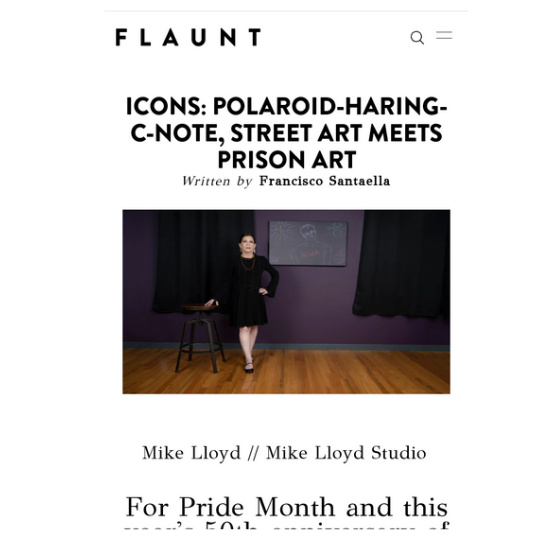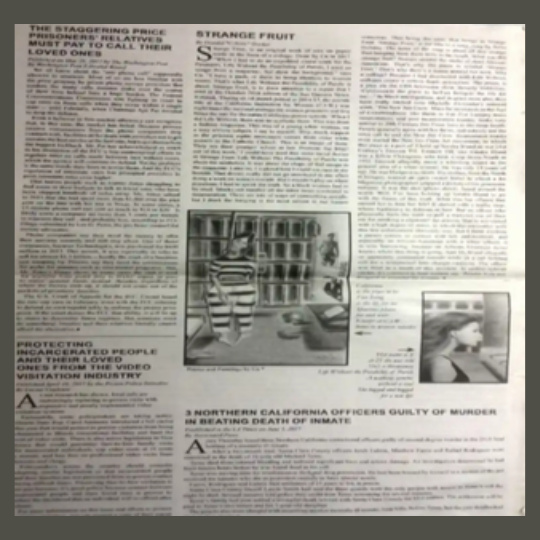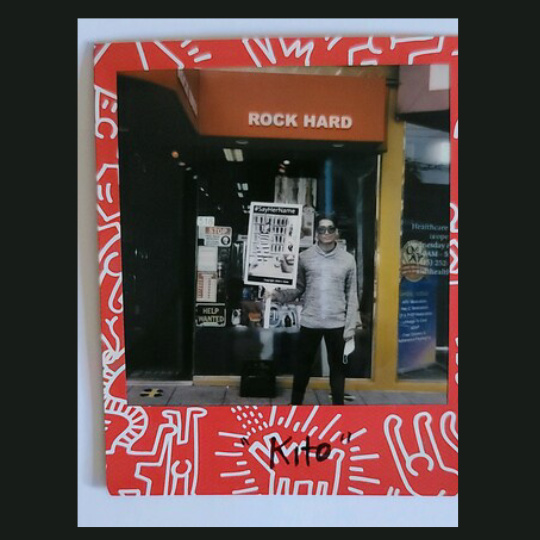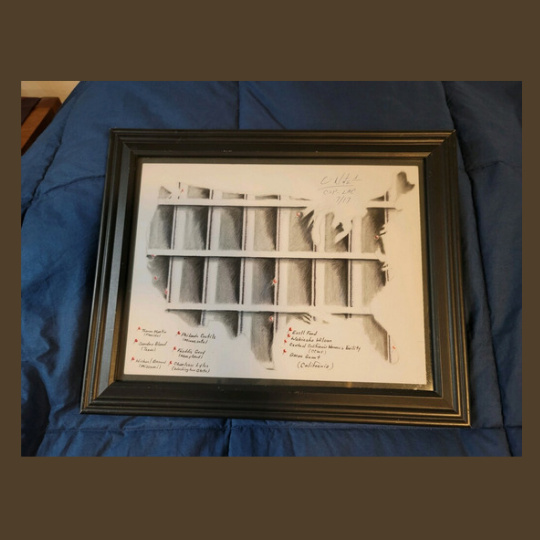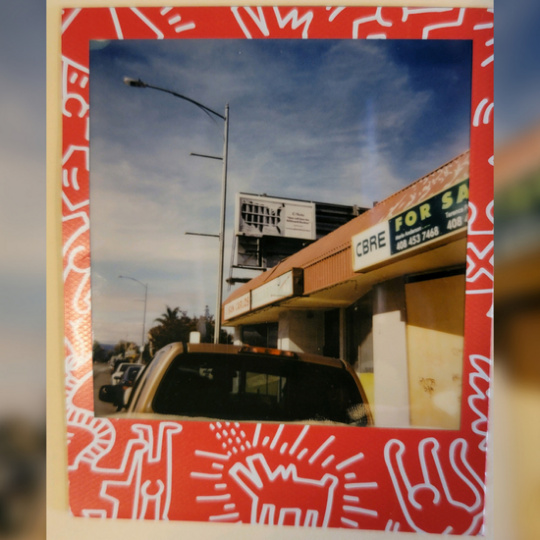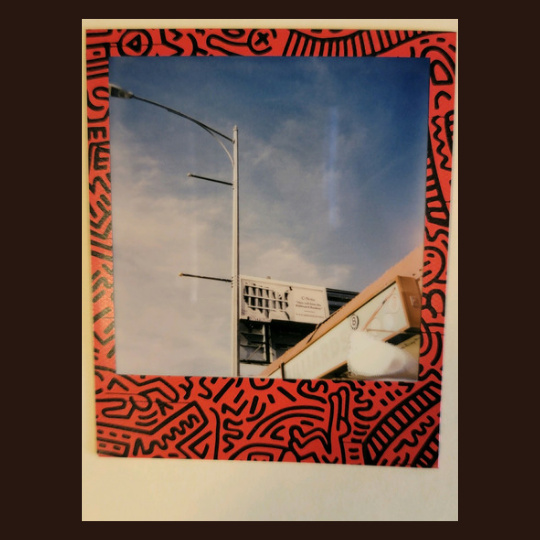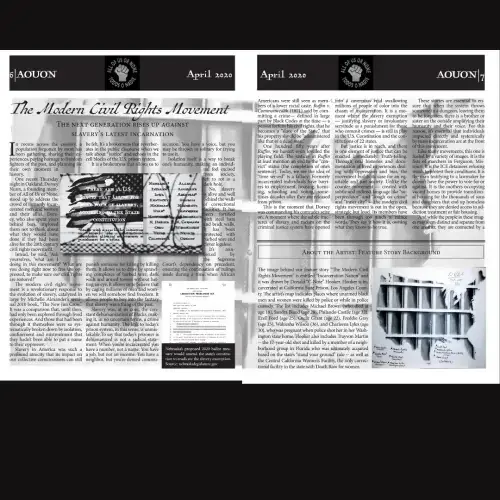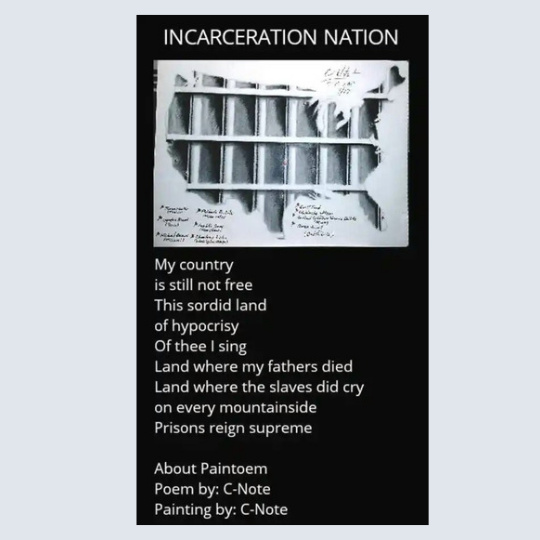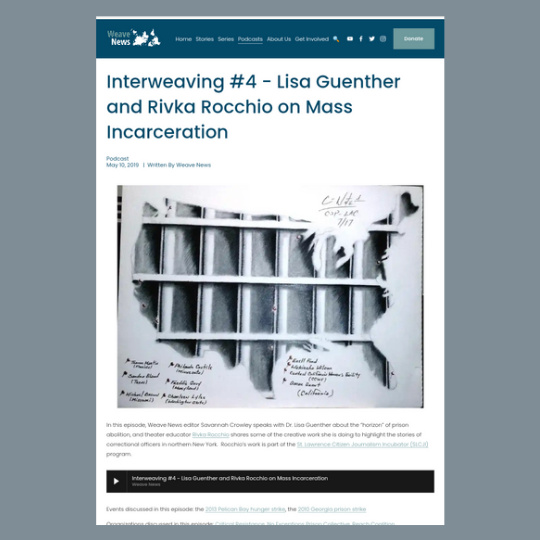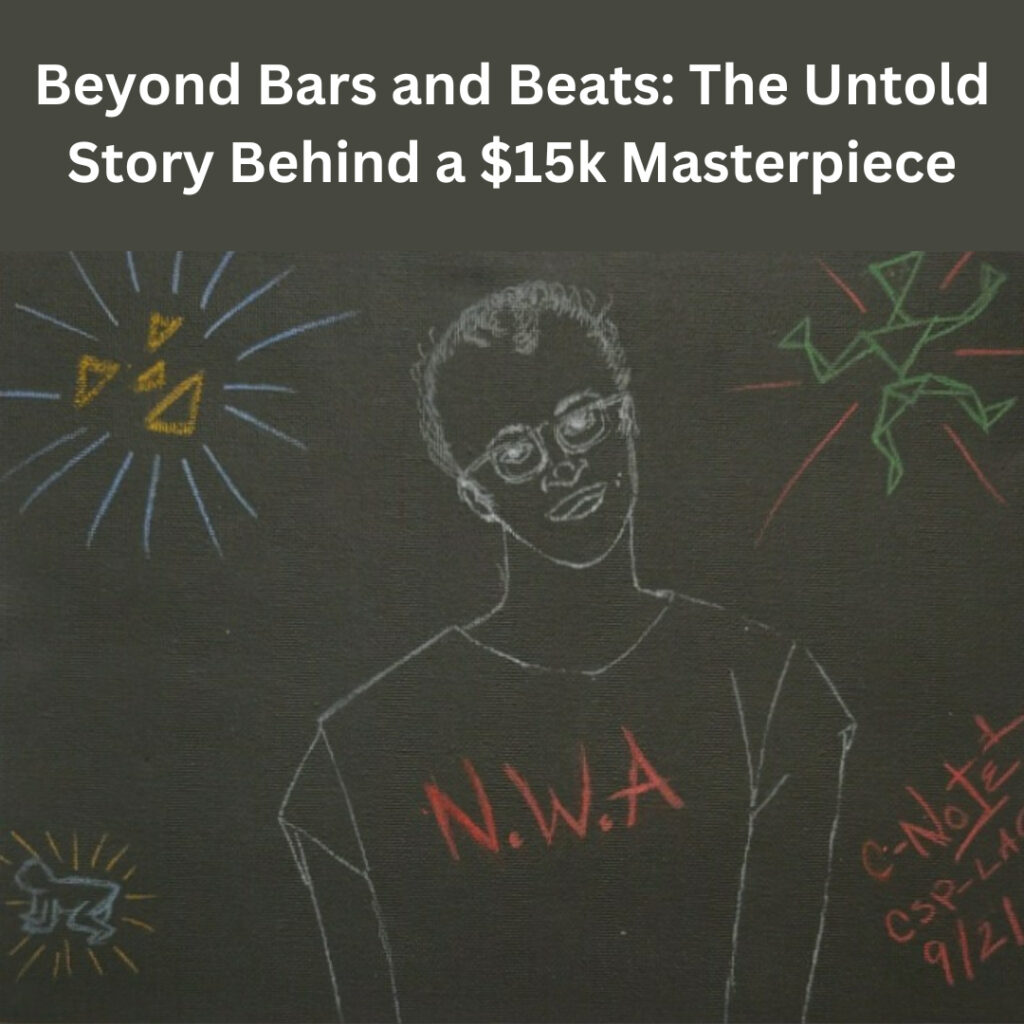
Beyond blue-chip, C-Note’s vibrant social commentary in “C-Note on Haring” reflects a market shift toward art that speaks truth to power.
I. Introduction
A. Brief overview of the contemporary art market’s shift.
In recent years, the contemporary art market has witnessed a significant shift. Once dominated by blue-chip artists known for their high-value and investment-worthy pieces, the market is now turning its gaze towards artists who bring fresh perspectives and address pressing social issues. This change reflects a broader cultural awakening, spurred by global movements calling for social justice and equality.
B. Introduction to Donald “C-Note” Hooker and his work “C-Note on Haring.”
Amidst this evolving landscape emerges Donald “C-Note” Hooker, an African American artist whose work transcends the confines of traditional art spaces. His piece C-Note on Haring is not just an artwork; it’s a statement, a conversation, and a reflection of the times. This work pays homage to Keith Haring, an artist renowned for his social activism, while infusing C-Note’s unique narrative and perspective.
C. The relevance of the piece in the context of changing collector preferences post-George Floyd.
The tragic death of George Floyd ignited a global reckoning with racial injustice, resonating deeply within the art community. Collectors, galleries, and institutions are now seeking art that not only holds aesthetic value but also embodies the spirit of this transformative era. C-Note on Haring with its poignant social commentary and artistic homage, stands at the intersection of this new demand, symbolizing the potential for art to influence and reflect societal change.
II. Donald “C-Note” Hooker: An Artist’s Profile
A. Background and artistic journey of C-Note.
Donald “C-Note” Hooker’s journey as an artist is as compelling as his creations. Incarcerated for most of his adult life, C-Note has turned the confines of his cell into a studio, proving that creativity knows no bounds. His art is a testament to resilience and the transformative power of self-expression. Over the years, C-Note has evolved into a multifaceted artist, involving poetry, playwriting, and performances, that have explored various mediums and themes, all while navigating the challenges of creating art behind bars.
B. Overview of C-Note’s style and thematic focus.
C-Note’s art is characterized by its vivid storytelling and poignant social commentary. Following the traditions of the Renaissance, landscapes, seascapes, portraits, figure drawing, and still life, achieve a luminous depth and texture that evoke the grandeur of classical oil paintings. His works frequently address themes of justice, struggle, and the human experience, reflecting his personal journey and the broader societal issues he observes.
C. Significance of C-Note as an African American artist in the contemporary art scene.
As an African American artist, C-Note brings a critical perspective to the contemporary art scene. His works offer a window into the experiences of marginalized communities, particularly those affected by the criminal justice system. In a market increasingly seeking diversity and depth, C-Note’s art resonates for its authenticity and its ability to challenge, move, and inspire.
III. “C-Note on Haring”: A Fusion of Legacy and Message
A. Description of “C-Note on Haring” and its elements.
C-Note on Haring is a striking visual tribute that combines the iconic style of Keith Haring with C-Note’s unique artistic language. On a black canvas, the work features a portrait of Haring wearing a T-shirt emblazoned with the NWA logo, surrounded by graphic elements made entirely of triangles. These include a radiant baby, a smiling face, and a dancing figure, each symbolizing different facets of life, art, and resistance. The use of complementary colors and geometric shapes creates a dynamic and engaging composition that draws the viewer into a deeper contemplation of its meaning.
B. The symbolism behind the graphic marks and the use of Keith Haring’s influence.
The graphic marks in C-Note on Haring are not just visual elements; they are laden with symbolism.
The radiant baby, a nod to Haring’s famous motif, represents innocence and potential, while the smiling face and dancing figure suggest joy and movement.
By incorporating these symbols, C-Note pays homage to Haring’s legacy of creating graphic contour images with movement, and of using art for social impact.
“While I hold the view, drawing is difficult,” recalls C-Note. “I wanted to show others through art, and through Keith Haring’s style, that it can be rather simple, if you stick to basic geometric shapes. Those two images, smiling face and dancing man are deliberate teaching moments from the canvas to the viewer. I had hoped it would inspire others to pick up the pencil or pen,” states C-Note. “This kind of teaching from the canvas is the fifth cipher of Hip Hop, Knowledge.”
The NWA T-shirt adds a layer of commentary on race, culture, and resistance, aligning Haring’s activism with the themes of racial injustice and empowerment that NWA represented.
C. The portrayal of social justice themes through the imagery of Keith Haring wearing an NWA T-shirt.
The image of Keith Haring wearing an NWA T-shirt is a powerful confluence of art and social justice. It bridges the gap between Haring’s fight against inequality and the outspoken resistance of NWA against systemic racism and police brutality. This portrayal is a bold statement on the enduring struggle for justice and the role of artists and cultural figures in that fight. It reflects a shared lineage of activism and underscores the continued relevance of art as a medium for social commentary and change.
Artivist, and Bay Area Rapper MinisterKingXPyeface, who served time with C-Note in the 2000s and 2010s agrees. “In 2023, I did a photoshoot with a 2022, 36″x24″, Plotter Pros single edition C-Note on Haring art print at Mike Lloyd’s Studio in Silicon Valley. At the time you just knew, it was a special piece of Hip Hop art. It embodied the culture. Haring’s signature glasses and the NWA T-shirt represents Hip Hop’s intellectualism and its bravado.”
IV. The Market Shift: From Blue-Chip to Socially Conscious Art
A. Discussion on the traditional art market dominated by artists like Jeff Koons.
For decades, the art market has been dominated by blue-chip artists such as Jeff Koons, whose works have become synonymous with high value and investment quality. These artists, often from a similar demographic and artistic tradition, have set the tone for what is considered desirable and collectible, commanding astronomical prices at galleries and auctions.
B. Impact of George Floyd’s death and the rise of social justice in art.
The death of George Floyd marked a pivotal moment, not just in societal reckoning with racial injustice but also in the art world’s reflection on its role and responsibilities. This event, among others, has accelerated a shift towards art that addresses social issues and represents diverse voices. Collectors, institutions, and the public are increasingly drawn to works that not only possess aesthetic value but also resonate with contemporary social consciousness and advocate for change.
C. How “C-Note on Haring” represents the new wave of art sought by collectors.
C-Note on Haring epitomizes the type of art that is gaining traction in this new market landscape. It’s a piece that not only showcases artistic skill and innovation but also engages deeply with themes of social justice, cultural legacy, and activism. As collectors look to make more meaningful acquisitions, works like C-Note on Haring stand out for their ability to connect with broader cultural dialogues and reflect the zeitgeist of a more socially aware era.
V. The Price of Change: Valuation and Potential
A. Current offering price of “C-Note on Haring” and its significance.
The original C-Note on Haring is currently offered at $15,000, a price that reflects its status as a unique and culturally significant piece. While this may be modest compared to the astronomical sums fetched by works from established blue-chip artists, it’s significant for an emerging artist like C-Note. This price point makes it accessible to a broader range of collectors, aligning with the democratizing spirit of the piece itself.
B. Comparison with the established prices of blue-chip artists.
Artworks by blue-chip artists like Jeff Koons have historically commanded millions of dollars, reflecting their established market presence and perceived investment value. However, as the art market evolves, the value proposition of such works is being reconsidered. While they may continue to be valuable, the growing interest in socially conscious and diverse art could see a recalibration of what is deemed valuable and collectible.
C. Factors that might influence “C-Note on Haring” in the secondary market.
Several factors could influence the future value of C-Note on Haring in the secondary market. These include the growing recognition of C-Note as an artist, the increasing importance of social justice themes in art, and the piece’s cultural and historical relevance. As the narrative around art and value continues to evolve, works like C-Note on Haring that speak to contemporary issues and resonate with a broader societal shift have the potential to see increased demand and appreciation.
VI. Broader Implications and Cultural Significance
A. “C-Note on Haring” as a cultural artifact reflecting hip-hop and art history.
C-Note on Haring is more than just a piece of art; it’s a cultural artifact that encapsulates the intersection of hip-hop and art history. By featuring Keith Haring, an artist known for his social activism, and referencing NWA, a group central to hip-hop’s commentary on racial injustice, C-Note seamlessly blends the streetwise grit of NWA’s rhymes with the socially conscious energy of Haring’s vibrant lines.
The result is a powerful symphony of voices, each one rising in unison for justice, a testament to the unwavering spirit that fuels both hip-hop and art. C-Note, “The King of Prison Hip Hop,” becomes the conductor of this cultural symphony, orchestrating a dialogue that transcends boundaries and demands attention.
B. The role of art in driving and reflecting societal change.
Art has long been a mirror to society, reflecting its beauty and its ills. C-Note on Haring exemplifies how art can drive and reflect societal change. Through its visual narrative and symbolic elements, it engages with pressing social issues, encouraging viewers to reflect, discuss, and perhaps act. As the art market shifts towards more socially conscious works, pieces like this underscore the potential of art to contribute to and catalyze societal change.
C. The importance of diversity and representation in the art world.
The increasing demand for art that reflects a diverse range of voices and experiences is a positive shift towards a more inclusive art world. C-Note on Haring created by an African American artist who has faced significant challenges, highlights the importance of diversity and representation. It shows that a wide range of perspectives is essential for a vibrant and relevant cultural discourse, and it challenges the art world to continue broadening its horizons.
VII. Conclusion
A. Recap of “C-Note on Haring’s” significance in the current art market.
C-Note on Haring emerges as a poignant reflection of the current art market’s evolution. It embodies the shift from blue-chip dominance to a more inclusive and socially conscious art landscape. This piece, with its rich cultural references and social commentary, captures the essence of a market that increasingly values diversity, relevance, and meaning.
B. The potential future of socially conscious art and artists like C-Note.
The future looks promising for socially conscious art and artists like C-Note. As societal issues continue to influence public discourse, the art world is likely to see a sustained interest in works that address these themes. Artists who can articulate the complexities of our time through their art will play a crucial role in shaping the cultural narrative and potentially the art market’s future.
C. Final thoughts on the evolving relationship between art, society, and the market.
The relationship between art, society, and the market is in a state of flux, reflecting broader cultural shifts and a reevaluation of values. C-Note on Haring is a microcosm of this dynamic interplay, demonstrating how art can be both a product of its time and a catalyst for change. As we move forward, the art world’s challenge will be to nurture and sustain this evolution, ensuring that art remains a vital, responsive, and inclusive part of our societal fabric.
VIII. Call to Action
A. Encouragement for readers to view and consider “C-Note on Haring.”
We invite readers to view C-Note on Haring and consider its messages and implications. Engage with the piece, reflect on its themes, and join the conversation about the role of art in society and the evolving art market.
B. Invitation for discussion and engagement with the themes presented in the article.
We encourage readers to discuss and engage with the themes presented in this article. Share your thoughts, experiences, and perspectives on the shift towards socially conscious art and the importance of diversity and representation in the art world. Your voice is a valuable part of this ongoing dialogue.
C. How to purchase the original “C-Note on Haring”.
Anna D. Smith Fine Art and Real Estate Broker in Silicon Valley, whose trademarked motto is “Fine Art needs a Home and a Home needs Fine Art ®,” is the fine art brokerage firm to contact in order to purchase this 12″x9″ piece of quiet luxury. Besides its historical and cultural relevance, its $15K asking price makes C-Note on Haring a perfect fit in the quiet luxury home decor movement. Email anna@adsmith.broker
Other Social Justice Works by C-Note
#SayHerName Protest Poster; Incarceration Nation; Today We Are Sisters; and the fashion line Mercy.
In 2020, C-Note decided to have several of his works to become reimagined as protest posters. One such work was his 2018 paintoem, Strange Fruit, about the higher than national average rate of suicides at a California women’s prison, C.I.W.. Strange Fruit was reimagined as the protest poster #SayHerName.
In 2017, as a promotional work of art for the Millions for Prisoners Human Rights March on August 19th, 2017, C-Note created Incarceration Nation. Besides its obvious nature, it also contains, throughout the map, red stick pins of the locations of African American state-sanctioned murders, from Travon Martin in Florida to Charleen Lyles in Washington State. Incarceration Nation has now become America’s premier work of art on mass incarceration.
In 2018, C-Note created the paintoem Today We Are Sisters, a work of art designed to get reparations for the 150 California women prisoners who were forcibly sterilized. In the spring of 2021, California passed a law making available $7.5M in reparations to California women prisoners who were forcibly sterilized. The time to file for the money, sunsetted on December 31st, 2023. However, according to California Bay Area public broadcast KQED, “Survivors from California’s Period of Forced Sterilization Denied Reparations,” as of Oct. 25, 2023, 108 out of 510 applications had been approved.
In 2020, fourth year student Makenzie Stiles for her final year fashion dissertation at the prestigious 145-year-old, Columbus College of Art and Design, created the fashion line Mercy. The work was designed to give voice to the voiceless in the realm of incarceration. From 2019 – 2020 she worked with C-Note using his artwork and that of other prisoners.
The Covid-19 pandemic prevented fashion models from walking the Catwalk in Mercy at the 2020 CCAD Fashion Show which was canceled due to Covid-19 health restrictions. Mercy represented the first fashion line in the school’s history to have a fashion line featuring prison art. It also would have been a first in the history of the Catwalk to have models walk the runway in clothes featuring prison art.
His Art doesn’t live on walls but in the streets!


